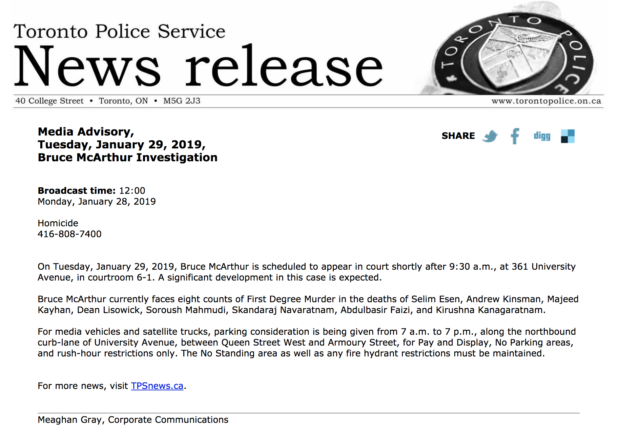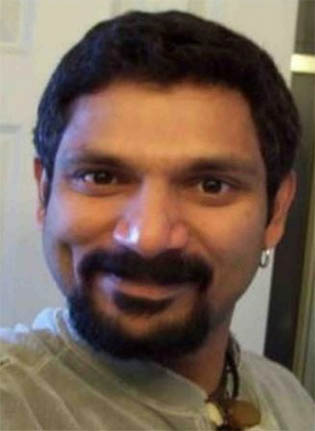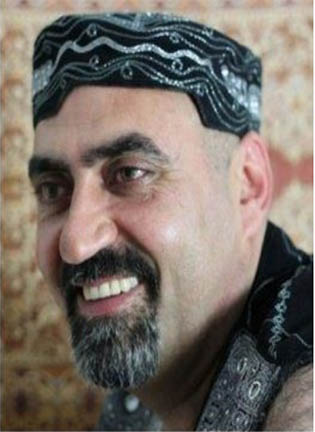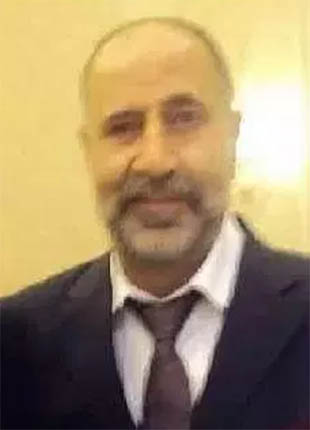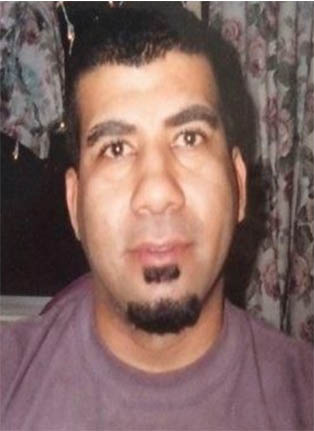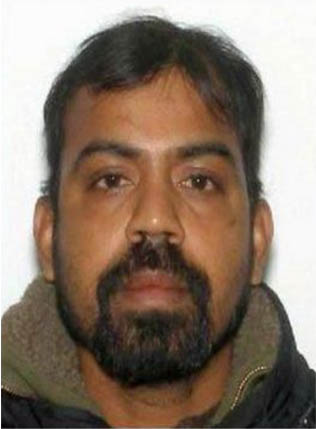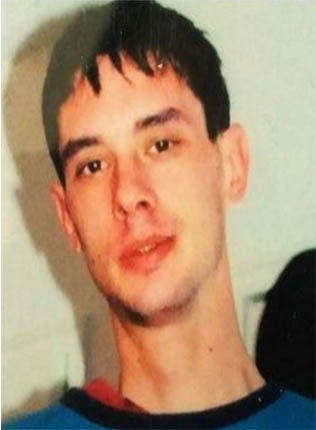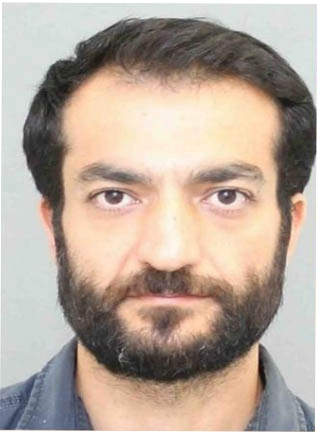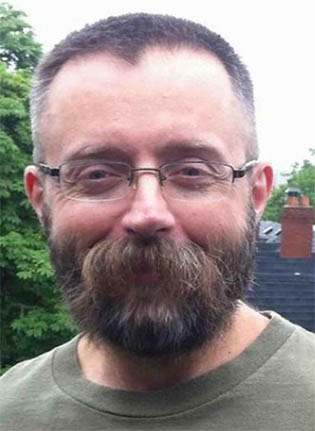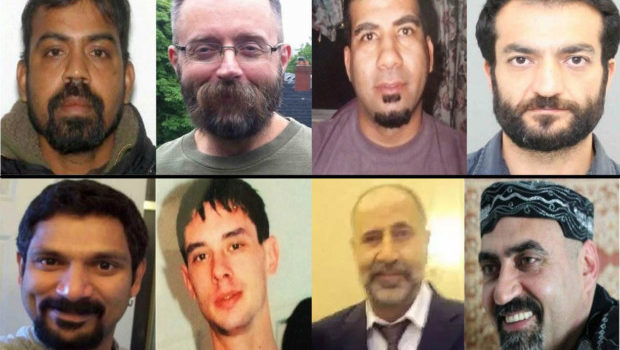

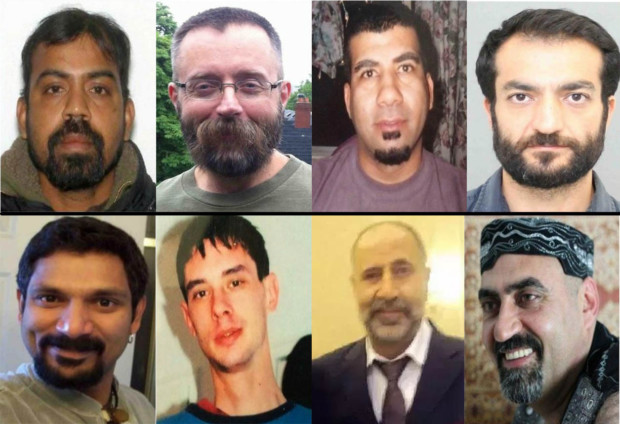
The case of serial killer Bruce McArthur’s has come to an end with his sentence to life in prison. Skedline.com reporter Paula Brown was in the courtroom for McArthur’s plea and his sentencing hearing.
The following is Brown’s report.
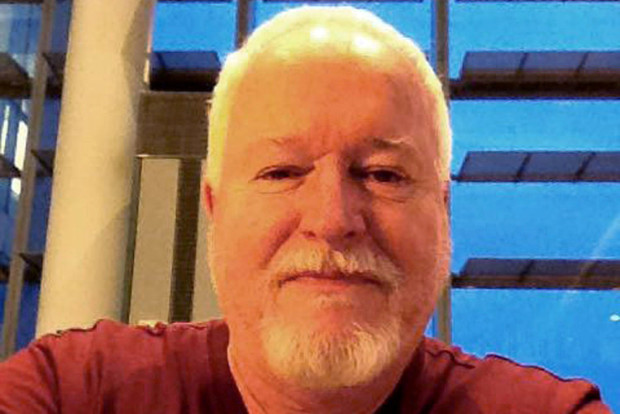
Serial killer Bruce McArthur, 67, in a photo posted on his social media account. Facebook/Handout via REUTERS/File Photo
The Guilty Plea
McArthur pled guilty to eight counts of first-degree murder before Superior Court Justice John McMahon Tuesday, Jan. 29.
With his plea, McArthur admitted to murdering eight men. Skandaraj Navaratnam, Abdulbasir Faizi, Majeed Kayhan, Soroush Mahmudi, Kirushnakumar Kanagaratnam, Dean Lisowick, Selim Esen, and Andrew Kinsman were killed between 2010 and 2017.
The media and the public knew something was coming in the case the day before McArthur admitted to his crime. Toronto Police released a media advisory on Jan. 28 saying “a significant development” in the case was expected.
Satellite trucks lined up outside the courthouse while crew members shoveled pathways in the snow. The courthouse was packed full of journalists and the energy in the courtroom buzzed.
McArthur walked into the courtroom wearing a black pullover sweater over a plaid shirt and dark jeans. He kept his head down and eyes focused on the ground.
He stood facing Justice John McMahon who asked him if he understood his guilty plea.
“You understand you will have to serve at least until you are 91 before you would be eligible to apply for parole?,” Justice McMahon asked, “You understand that?”
“Yes, your honour,” McArthur replied.
Justice McMahon then asked McArthur how he was pleading “guilty or not guilty” to each of the eight counts.
“Guilty,” McArthur said eight times for his eight victims.
After McArthur made his admissions of guilt, the statement of facts about the case was read out to the court.
The statement of facts detailed how the murders were committed. McArthur staged his victims, there was evidence of ligatures used, and six of the eight cases were sexual in nature.
“During each of these murders, one or more of the following factors were present: planning and deliberation, a murder committed in the course of sexually assaulting the victims, or a murder committed while the victims were unlawfully confined,” Crown attorney Michael Cantlon said as he read from the brief statement of facts.
Karen Fraser, owner of the Leaside home were the remains of the victims were found, was also present in the courtroom.
“The way I’m trying to look at it is, the man I knew actually didn’t exist,” said Fraser standing outside the courthouse. “That’s the best I can go with.”
Toronto Police Insp. Hank Idsinga and Det. David Dickinson also spoke with the media after the court appearance.
“We, unfortunately, can never bring these men back, but I’m hoping that we can start bringing some closure to the families and the communities,” said Dickinson.
“This isn’t about us,” said Dickinson. “But we did this because we wanted answers too.”
Evidence
Almost a week later Monday, Feb.4 was the first of the three-day sentencing hearing. The admitted statement of facts detailing the murders of each of the eight victims and victim impact statements were read into the court record.
“For years, members of the LGBTQ community in Toronto believed they were being targeted by a killer,” Crown attorney Michael Cantlon told the court in his opening statement. “They were right.”
The Crown started the admitted facts beginning with Andrew Kinsman’s murder and working through the evidence for each victim from 2010 to 2017.
McArthur’s car had been picked up by surveillance video outside Kinsman’s home. The surveillance time stamp aligned with a note that Kinsman had made on a calendar noting “Bruce” and the times “2 p.m. or 3 p.m.”
McArthur’s car had blood, semen, four male DNA profiles that belonged to Kinsman, and McArthur, and DNA belonging to Esen, Cantlon told the court.
Evidence showed McArthur’s computer had accessed a USB drive, and forensic analysis showed subfolders named after his victims, except for two that were simply titled “4” and “5”. A subfolder for a surviving victim “John” was also found.
“The directory contained eight folders corresponding to the eight victims Mr. McArthur murdered, as well as one for ‘John’,” Cantlon told the court.
The Crown described the gruesome details of the photos – the staging of the victims, five of them with a fur coat, and close-ups of their faces. The Crown also detailed for the court the ligature marks and ropes shown in some of the photos.
The victim’s belongings were also found in McArthur’s bedroom.
A bracelet belonging to Skandaraj Navaratnam, engraved with “Skanda”, a booklet belonging to Selim Esen and a necklace belonging to Dean Lisowick were all found.
“Mr. McArthur kept items of his victims long after the killings,” Cantlon told the court.
McArthur also kept hair from some of his victims, in bags in a shed located south of Mt. Pleasant Cemetery.
McArthur dismembered his victims.
Seven of the victims were buried in five plant pots. Majeed Kayhan was found buried by the ravine area in a container.
“There is also evidence that Mr. McArthur continued to move remains between the pots after the initial burial,” Cantlon told the court.
A duffle bag was found in McArthur’s bedroom with duct tape, surgical gloves, rope, zip ties, a black bungee cord, and syringes. A drawer in McArthur’s room contained a bar, rope and duct tape.
McArthur was arrested when police witnessed him bringing a victim known as “John” to his apartment. “John” survived.
Sentencing
On Friday, Feb. 8, Justice McMahon sentenced McArthur to life in prison for the murders of the eight men.
Justice McMahon ruled that McArthur serve the eight life sentences concurrently meaning the sixty-seven-year-old won’t be eligible for parole until he is 91.
“I am satisfied that when dealing with the protection of the public, concurrent periods of parole ineligibility can adequately address the protection of the public,” said Justice McMahon in his reasons for the sentence.
Justice McMahon told the courtroom the factors he considered in his decision on sentencing, which included the nature of the offenses, the nature of the killings and the victims, the impact on the families, friends, and community and McArthur’s guilty pleas to the eight counts of first-degree murder.
“The accused exploited his victims’ vulnerabilities, whether they involved immigration concerns, mental health challenges, or people living a secretive double life,” said Justice McMahon. “He also exploited others through a belief he was their friend.”
“The only reasonable inference that I can draw is that the accused is a sexual predator and killer who lured his victims on the pretext of consensual sex and he ended up killing them for his own warped and sick gratification.”
While Justice McMahon read the reasons for the sentencing aloud to the courtroom, he spoke of cases that have taken place throughout Canada dealing with multiple murders.
Out of approximately 26 cases across Canada involving multiple counts of first-degree murder, 15 have had consecutive periods of parole ineligibility. In five of these cases, the accused pled guilty, with only one in Ontario – Elizabeth Wettlaufer.
Elizabeth Wettlaufer, worked as a registered nurse for more than nine years and was arrested in 2016 for the murders of eight senior citizens between 2007 and 2014 in two separate nursing homes in London and Woodstock, ONT. Wettlaufer murdered her victims with a lethal injection of insulin. She was sentenced to eight concurrent life sentences without eligibility of parole for 25 years.
“The case that is closest on its facts is Wettlaufer,” said Justice McMahon.
While Justice McMahon related McArthur’s case to Wettlaufer’s, he also highlighted important differences in the two cases.
Justice McMahon said that while Wettlaufer had come forward showing remorse, in McArthur’s case there had been no evidence of it. He also said age was another of the important differences. Wettlaufer was 50 years old at the time of her sentencing and will be eligible to apply for parole when she is 75.
Wettlaufer will likely become eligible for parole in her life time while McArthur, eligible at the 91, will likely not.
The Crown had asked for ineligibility of parole for 50 years which would see McArthur eligible at the age of 116.
But Justice McMahon said, “there is a fine line between retribution which is an appropriate sentencing principle and vengeance.”
McArthur’s case might be done in the courts, but there are still unanswered questions such as where the dismemberment of the bodies happened.
“We don’t have the evidence to say where he committed the dismemberments, whether the dismemberments were committed in the same place or in multiple places.” said Idsinga during a press conference on the day of McArthur’s sentencing.
A timeline of the murders shows McArthur’s first victim Skandaraj Navaratnam was killed in 2010. There is still public uncertainty that Navaratnam was McArthur’s first murder.
Insp. Idsinga told CBC Metro Morning on Feb. 11 that he hadn’t spoken with McArthur but if he ever did he would like to establish a better timeline to ease concerns that the murder of Skandaraj Navaratnam in 2010 was the first.
There is also the question of where McArthur will be imprisoned.
“He goes to Corrections Canada and it’s up to them to place him for the safety of himself but also the safety of the general public,” said Det. Dickinson.
The Victims
Skandaraj Navaratnam
Skandaraj Navaratnam was known as Skanda to his friends and family. He came to Canada from Sri Lanka, enrolled in the University of Toronto and was a professor’s aide.
Skandaraj was 40 when McArthur murdered him.
Skandaraj was the second oldest of four siblings. His brother described him as their mother’s favourite boy.
Friends said he was outgoing, social, and always there to help.
“He left a mark on everyone he met,” his friend Jean-Guy Cloutier said in his victim impact statement.
He loved animals, nature, enjoyed fish and aquariums and was almost unbeatable at Scrabble.
“He was our bright shining star,” said friend Kevin Nash in his impact statement.
Abdulbasir Faizi
Abdulbasir Faizi, whose nickname was Basir, was a husband and a father to two. His daughters were six and 10 years old when he went missing.
“They talk about the times their father would play with them and their memories of them together,” said his wife Kareema Faizi, in her victim impact statement. “That’s all they have left of him now.”
She also said that they suffer knowing what had happened to their father.
Abdulbasir worked as a pressman for a company in Mississauga. He left work on Dec. 29 and was reported missing on Dec. 30, 2010.
Kareema Faizi said she is working 16-18-hour days now, “because that is what is required to provide for my family.”
Abdulbasir was 44 when McArthur murdered him.
Majeed Kayhan
Majeed Kayhan came to Canada from Afghanistan.
“We agonised over the disappearance of my brother since 2012, not being able to understand where he went and what happened to him, to finally be notified of his horrific and brutal murder,” his brother Jalil Kayhan said in his victim impact statement.
“I don’t know that I can properly describe the pain and suffering that I and my family have gone through over the years and I believe that this suffering will continue to affect us forever.”
Majeed was a father of two and grandfather of three, the youngest of his siblings and an uncle to his nieces and nephews.
“My brother leaves behind many older siblings, nieces and nephew, two children, three grandchildren who will never be able to enjoy his presences again,” said Kayhan.
Majeed was 58 when McArthur murdered him.
Soroush Mahmudi
Soroush Mahmudi was born in Iran and left in 1991. After going to Turkey he came to Canada as a refugee, originally living in Windsor but settling in Toronto.
Soroush married his wife Umme Fareena Marzook in 2003.
“My pain and suffering will always be there as long as I live and I will constantly be reminded of how my beloved and innocent husband was brutally murdered,” Marzook said in her victim impact statement.
Marzook reported him missing on Aug. 22, 2015, and found out on Jan. 25, 2018 that Soroush was a one of McArthur’s victims.
“In hearing the news I fainted as I was in a state of severe shock and became numb,” said Marzook.
Soroush was 49 when McArthur murdered him.
Kirushnakumar Kanagaratnam
Kirushnakumar Kanagaratnam came to Canada from Sri Lanka as a refugee in 2010 on the MV Sun Sea, a cargo ship that brought 492 refugees from Sri Lanka to British Columbia in 2010.
“The day that we reached the shores of Canada, as refugees, was the day we found courage and hope in our hearts,” a friend said Piranavan Thangavel. “But that hope and courage has faded in many of us.”
Kirushnakumar remained friends with the people that he travelled to Canada with. On a weekly basis, he would met friends at a local convenience store and frequently contacted his family who lived out of Canada.
“I find it impossible to classify this killer as a human. I cannot find any attribute of humanity in him I am also unable to comprehend his state of mind and thoughts. It brings untellable fear to my heart to think about it,” said Thangavel.
Kirushnakumar’s refugee claim was denied in April 2015 and he was scheduled for deportation in September of that year.
His disappearance was never reported to police.
He was 37 when McArthur murdered him.
“To kill someone is one thing, but to subject one to prolonged torture before killing them is beyond abhorrent,” said Thangavel.
Dean Lisowick
Dean Lisowick was a father, grandfather, son, nephew, and cousin.
“Even though I never knew him there was still a chance that maybe one day I would be able to meet him, bump into him downtown and talk to him but now that is all gone,” said his daughter Emily Bourgeois who had never met her dad, in her victim impact statement.
Dean’s uncle Gerry Montani said in his victim impact statement that Dean was as a great joy to his parents and a loving and caring man.
“His face lit up when he talked about his daughter,” Dean’s cousin Julie Pearo said in her victim impact statement.
Pearo also said that in the last few times she had seen him that he was setting goals and plans for himself.
“I just want to hug him, be hugged by him, laugh, scheme, reminisce, get old,” said Pearo. “I want him back.”
Dean struggled with mental health and was last seen when he was discharged from the Extreme Weather Program at the Scott Mission. No one reported him missing.
He was 43 when McArthur murdered him.
Selim Esen
Selim Esen’s family described him as intelligent, kind, generous, and selfless.
He had an inquisitive mind and stood firm for fairness and social injustice his family said in the victim impact statement.
“We can’t come to terms with his savage murder,” said the family. “It is like part of our body is cut into pieces and will keep bleeding forever.”
Selim loved nature, textile design and managing a café. He also had a passion for studying sociology and philosophy.
“He was a romantic and believed in the power of love,” said his friend Richard Kikot.
“Selim spent his life asking why,” said the family. “We will continue his quest and will keep asking why.”
Selim was 44 when McArthur murdered him.
Andrew Kinsman
Andrew Kinsman’s family said he was generous, compassionate and thoughtful.
“He was a diverse individual,” said his youngest sister Shelley Kinsman. “He could be found baking in his kitchen, volunteering at the food bank, lending an ear or partaking in a debatable discussion.”
“He wanted to make the world a better place for those struggling to survive,” said another sister Karen Coles. “He was the champion of the underdog.”
“Never in my wildest dreams did I envision his life ending the way it did,” said sister Patricia Kinsman.
“I look at strangers differently now,” said Andrew’s brother Stephen. “Wondering if they are capable of such acts.”
Andrew loved working in the outdoors. His friends described him as smart, wise and kind.
“My life has been truly fractured. My heart, soul and spirit have been fractured. They may heal in time but it will never be the same and it will never go away, and it will be with me for the rest of my life,” said his friend Greg Dunn.
“He stole from us someone who was valuable, loved and admired,” said another friend Edward Healey.
Andrew was 49 when McArthur murdered him.

